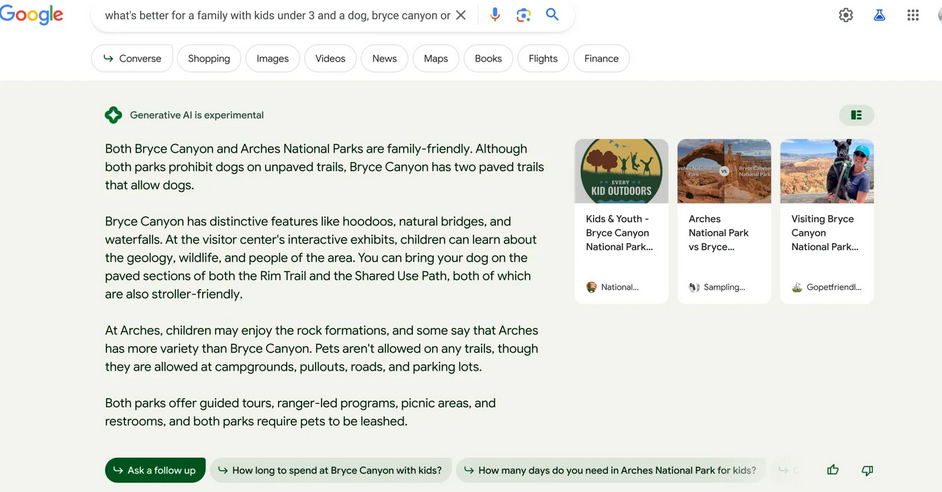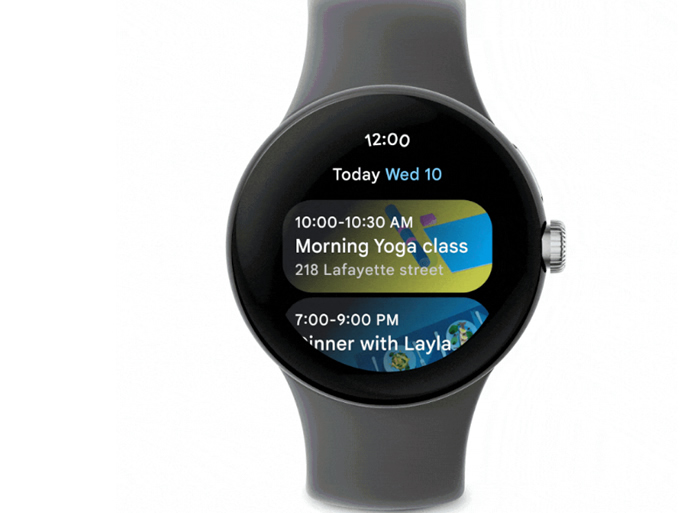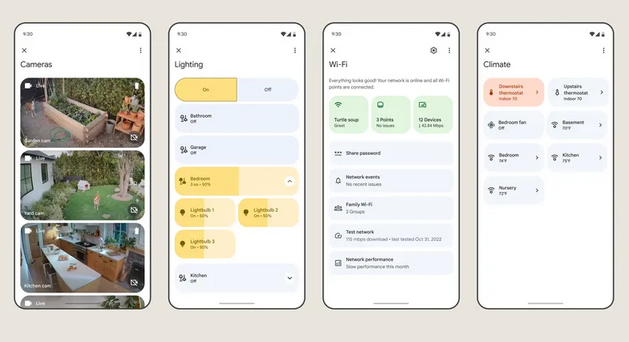 Technology peripherals
Technology peripherals
 AI
AI
 Nine highlights of the 2023 Google I/O conference: the first foldable screen mobile phone is released, and AI becomes the protagonist!
Nine highlights of the 2023 Google I/O conference: the first foldable screen mobile phone is released, and AI becomes the protagonist!
Nine highlights of the 2023 Google I/O conference: the first foldable screen mobile phone is released, and AI becomes the protagonist!

Expand the Pixel product line, Google releases its first folding screen phone
Google launches Three new Pixel products have been launched, namely Pixel Fold, Pixel Tablet, and the price-friendly Pixel 7A.
Pixel Fold is priced at US$1,799. This is the first time Google has launched a foldable screen phone. The phone is equipped with two displays, one is a 5.8-inch OLED outer screen, and there is a 7.6-inch inner screen after unfolding. Refresh rate 120Hz. Pixel Tablet is an 11-inch tablet computer that is priced at $499. Thanks to its magnetic charging base (which is also a speaker), the tablet can be transformed into a smart display.
Pixel 7A is priced relatively friendly. It is equipped with a Tensor G2 chip and is equipped with a 6.1-inch 1080 display with a refresh rate of 90Hz. The base model of the Pixel 7A is priced at $499, while the version with millimeter wave technology is priced at $549.

Google search adds a new feature called "AI Snapshot". Turn on "Search Generative Experience" (SGE), and when you query certain questions, you will see AI-generated answers in the answers. You can provide more contextual information for searches, and you can narrow the scope of information in the snapshot through follow-up questions.
Google has enhanced its Large Language Model (LLM), named Palm 2, and the new model has been applied by AI Snapshot. Google already has 25 services enabled with the new model, including the Bard chatbot. Palm 2 has improvements in reasoning, programming, and translation.
Bard will be open to everyone
Google has officially opened Bard to everyone, and has added many new features , such as supporting Japanese and Korean, making it easier to generate text in Google Docs and Gmail. In addition, Google has also added night mode and visual search functions, and more functions will be added in the future. Adobe has developed an AI image generator called Firefly that will integrate Google Bard. Google will also integrate other third-party services, such as OpenTable and Instacart.

Android adds AI customization options
Android adds a feature called Magic Compose, which is located in the Messages App. When chatting Artificial intelligence can be used to suggest reply messages. There is also an interesting feature, you can use AI to design personalized wallpapers. Google is launching a feature exclusive to Pixel phones next month that will add depth to existing photos to create impressive "movie wallpapers."

Better Wear OS 4 will be unveiled at the end of the year
Although Wear OS 3 has not yet been fully promoted, Wear OS 4 is scheduled to be launched by the end of this year. According to Google, Wear OS 4 can extend battery life, users can back up and restore watch data, and Wear OS 4 also adds new connectivity features. In addition, the integration of Wear OS 4 with smart home devices will be further improved, allowing you to control lights, media, and view camera images.

Renovated Google Home app
The newly designed Google Home app is officially open to everyone, and some areas have been upgraded. For example, it has a better camera interface, new Favorites tags, and supports more device types.
Google search adds Perspectives function
Google’s newly added Perspectives function can directly retrieve answers from Reddit, Stack Overflow, YouTube, personal blogs and other websites, which is equivalent to Let real people answer search questions.
Google Photos adds AI image editing functions
Google Photos adds some interesting AI editing functions, such as enhancing sky color, moving people or other objects in pictures, and eliminating The person behind it. The new Google Photos will be available to select Pixel users by the end of the year.

Launching Duet AI for Workspace
Duet AI is the new name for a suite of AI tools that are integrated into Docs, In Sheets, Slides, Meet and Gmail. With the support of AI, Workspace can write emails and generate pictures. (Knife)
The above is the detailed content of Nine highlights of the 2023 Google I/O conference: the first foldable screen mobile phone is released, and AI becomes the protagonist!. For more information, please follow other related articles on the PHP Chinese website!

Hot AI Tools

Undresser.AI Undress
AI-powered app for creating realistic nude photos

AI Clothes Remover
Online AI tool for removing clothes from photos.

Undress AI Tool
Undress images for free

Clothoff.io
AI clothes remover

AI Hentai Generator
Generate AI Hentai for free.

Hot Article

Hot Tools

Notepad++7.3.1
Easy-to-use and free code editor

SublimeText3 Chinese version
Chinese version, very easy to use

Zend Studio 13.0.1
Powerful PHP integrated development environment

Dreamweaver CS6
Visual web development tools

SublimeText3 Mac version
God-level code editing software (SublimeText3)

Hot Topics
 1377
1377
 52
52
 How to create an oracle database How to create an oracle database
Apr 11, 2025 pm 02:33 PM
How to create an oracle database How to create an oracle database
Apr 11, 2025 pm 02:33 PM
Creating an Oracle database is not easy, you need to understand the underlying mechanism. 1. You need to understand the concepts of database and Oracle DBMS; 2. Master the core concepts such as SID, CDB (container database), PDB (pluggable database); 3. Use SQL*Plus to create CDB, and then create PDB, you need to specify parameters such as size, number of data files, and paths; 4. Advanced applications need to adjust the character set, memory and other parameters, and perform performance tuning; 5. Pay attention to disk space, permissions and parameter settings, and continuously monitor and optimize database performance. Only by mastering it skillfully requires continuous practice can you truly understand the creation and management of Oracle databases.
 How to create oracle database How to create oracle database
Apr 11, 2025 pm 02:36 PM
How to create oracle database How to create oracle database
Apr 11, 2025 pm 02:36 PM
To create an Oracle database, the common method is to use the dbca graphical tool. The steps are as follows: 1. Use the dbca tool to set the dbName to specify the database name; 2. Set sysPassword and systemPassword to strong passwords; 3. Set characterSet and nationalCharacterSet to AL32UTF8; 4. Set memorySize and tablespaceSize to adjust according to actual needs; 5. Specify the logFile path. Advanced methods are created manually using SQL commands, but are more complex and prone to errors. Pay attention to password strength, character set selection, tablespace size and memory
 How to write oracle database statements
Apr 11, 2025 pm 02:42 PM
How to write oracle database statements
Apr 11, 2025 pm 02:42 PM
The core of Oracle SQL statements is SELECT, INSERT, UPDATE and DELETE, as well as the flexible application of various clauses. It is crucial to understand the execution mechanism behind the statement, such as index optimization. Advanced usages include subqueries, connection queries, analysis functions, and PL/SQL. Common errors include syntax errors, performance issues, and data consistency issues. Performance optimization best practices involve using appropriate indexes, avoiding SELECT *, optimizing WHERE clauses, and using bound variables. Mastering Oracle SQL requires practice, including code writing, debugging, thinking and understanding the underlying mechanisms.
 How to add, modify and delete MySQL data table field operation guide
Apr 11, 2025 pm 05:42 PM
How to add, modify and delete MySQL data table field operation guide
Apr 11, 2025 pm 05:42 PM
Field operation guide in MySQL: Add, modify, and delete fields. Add field: ALTER TABLE table_name ADD column_name data_type [NOT NULL] [DEFAULT default_value] [PRIMARY KEY] [AUTO_INCREMENT] Modify field: ALTER TABLE table_name MODIFY column_name data_type [NOT NULL] [DEFAULT default_value] [PRIMARY KEY]
 What are the integrity constraints of oracle database tables?
Apr 11, 2025 pm 03:42 PM
What are the integrity constraints of oracle database tables?
Apr 11, 2025 pm 03:42 PM
The integrity constraints of Oracle databases can ensure data accuracy, including: NOT NULL: null values are prohibited; UNIQUE: guarantee uniqueness, allowing a single NULL value; PRIMARY KEY: primary key constraint, strengthen UNIQUE, and prohibit NULL values; FOREIGN KEY: maintain relationships between tables, foreign keys refer to primary table primary keys; CHECK: limit column values according to conditions.
 Detailed explanation of nested query instances in MySQL database
Apr 11, 2025 pm 05:48 PM
Detailed explanation of nested query instances in MySQL database
Apr 11, 2025 pm 05:48 PM
Nested queries are a way to include another query in one query. They are mainly used to retrieve data that meets complex conditions, associate multiple tables, and calculate summary values or statistical information. Examples include finding employees above average wages, finding orders for a specific category, and calculating the total order volume for each product. When writing nested queries, you need to follow: write subqueries, write their results to outer queries (referenced with alias or AS clauses), and optimize query performance (using indexes).
 How to configure Debian Apache log format
Apr 12, 2025 pm 11:30 PM
How to configure Debian Apache log format
Apr 12, 2025 pm 11:30 PM
This article describes how to customize Apache's log format on Debian systems. The following steps will guide you through the configuration process: Step 1: Access the Apache configuration file The main Apache configuration file of the Debian system is usually located in /etc/apache2/apache2.conf or /etc/apache2/httpd.conf. Open the configuration file with root permissions using the following command: sudonano/etc/apache2/apache2.conf or sudonano/etc/apache2/httpd.conf Step 2: Define custom log formats to find or
 What does oracle do
Apr 11, 2025 pm 06:06 PM
What does oracle do
Apr 11, 2025 pm 06:06 PM
Oracle is the world's largest database management system (DBMS) software company. Its main products include the following functions: relational database management system (Oracle database) development tools (Oracle APEX, Oracle Visual Builder) middleware (Oracle WebLogic Server, Oracle SOA Suite) cloud service (Oracle Cloud Infrastructure) analysis and business intelligence (Oracle Analytics Cloud, Oracle Essbase) blockchain (Oracle Blockchain Pla



